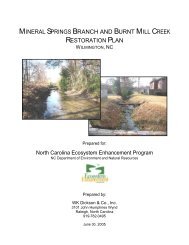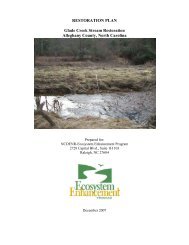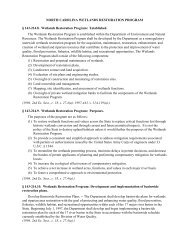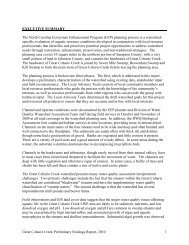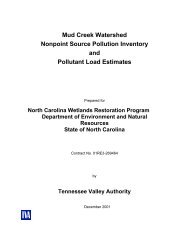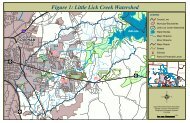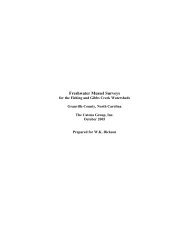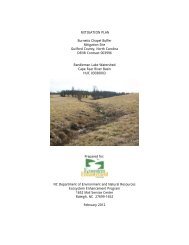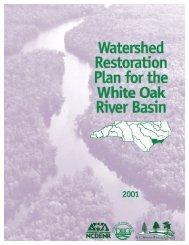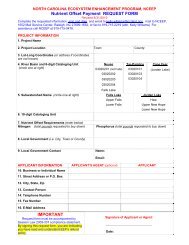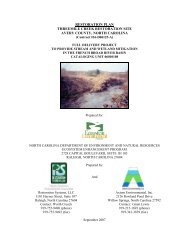Mud Creek Watershed Restoration Plan - Henderson County Center
Mud Creek Watershed Restoration Plan - Henderson County Center
Mud Creek Watershed Restoration Plan - Henderson County Center
Create successful ePaper yourself
Turn your PDF publications into a flip-book with our unique Google optimized e-Paper software.
Local governments in <strong>Henderson</strong> <strong>County</strong> including <strong>Henderson</strong>ville, Flat Rock and Laurel Park,are subject to requirements of the National Pollutant Discharge Elimination System (NPDES)Phase II Stormwater Program. Phase II of the NPDES stormwater program requires smallmunicipal separate storm sewer systems (MS4s) to obtain an NPDES permit. A small MS4 is acity, town, county, association or other public body that owns or operates a stormwater collectionsystem. Regulated small MS4s automatically designated by the Environmental ProtectionAgency must apply for a permit by March 2003 and are required to develop and implement acomprehensive stormwater management program that includes 6 minimum measures:1) Public education and outreach on stormwater impacts.2) Public involvement/participation.3) Illicit discharge detection and elimination.4) Construction site stormwater runoff control.5) Post-construction stormwater management for new development and redevelopment.6) Pollution prevention/good housekeeping for municipal operations.Although the Phase II requirements will help to address many of the water quality problemsassociated with stormwater in urban areas, they are unlikely to solve the stormwater velocity andvolume problems in watersheds such as <strong>Mud</strong> <strong>Creek</strong> that already have a high percentage ofimpervious cover. The following ordinance revisions recommended by the <strong>Mud</strong> <strong>Creek</strong><strong>Watershed</strong> <strong>Restoration</strong> Council are consistent with the Phase II requirement for controlling postconstructionrunoff; however, in some cases, the changes recommended by the Council exceedthe requirements of the Phase II program. To truly address the stormwater problem, localgovernments in the <strong>Mud</strong> <strong>Creek</strong> watershed will need to think beyond compliance with the PhaseII stormwater program and take proactive steps to minimize impervious cover and controlstormwater from new developments, redevelopments, and to retrofit old developments.3.1.2 Strategies to minimize impacts of stormwater runoff from future developmentLocal governments in the <strong>Mud</strong> <strong>Creek</strong> watershed should consider minimizing futurestormwater impacts by developing and/or refining existing stormwater managementordinances and floodplain development ordinances.The <strong>Mud</strong> <strong>Creek</strong> Council studied existing stormwater ordinances in light of the Phase IIrequirements for local governments in the <strong>Mud</strong> <strong>Creek</strong> watershed and determined that thefollowing modifications would help these governments achieve maximum stormwater reductionsfrom new development:All local stormwater ordinances should specify maintenance requirements for structuralstormwater Best Management Practices (BMPs). Ordinances should also specify that designpractices that reduce impervious cover and maintain stream-side areas in natural vegetationand floodplain or use vegetated swales to convey stormwater are preferred to structuralpractices for stormwater control.All local governments in the <strong>Mud</strong> <strong>Creek</strong> watershed should implement inspection programs toensure compliance with stormwater ordinances, including proper installation andmaintenance of structural BMPs.Section 3: Recommendations Page 30




